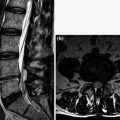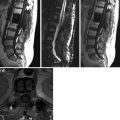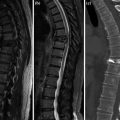Tommaso Scarabino and Saverio Pollice (eds.)Imaging Spine After Treatment2014A Case-based Atlas10.1007/978-88-470-5391-5_2
© Springer-Verlag Italia 2014
2. Interventional Radiology
(1)
Department of Radiology—Neuroradiology, “Lorenzo Bonomo” Hospital, Andria, Italy
(2)
Department of Neurosurgery, “Lorenzo Bonomo” Hospital, Andria, Italy
Abstract
Interventional radiology of the spine includes a set of minimally invasive surgical procedures with percutaneous approach, used primarily for the treatment of diskal hernia (especially lumbar) and vertebral collapse of different nature.
Interventional radiology of the spine includes a set of minimally invasive surgical procedures with percutaneous approach, used primarily for the treatment of diskal hernia (especially lumbar) and vertebral collapse of different nature [1].
These techniques involve short time hospitalization, are usually practicable in day surgery, and do not require general anesthesia.
2.1 Percutaneous Techniques for Diskal Hernia
Interventional techniques with percutaneous approach for diskal hernia are based on the principle of “empty of nucleus pulposus” (both by physical and chemical ways) in order to reduce its volume and thus indirectly the compression of nerve root. Compared to surgery, they are less invasive, with similar efficacy and lower risk of recurrences, thanks to an external approach. They also have the advantage of being repeatable without precluding, in case of failure, the use of traditional surgery [2].
They find indication especially in young patients with disk protrusion, where disk degeneration is the only source of pain, and therefore, all the degenerative phenomena typical of the advanced age are absent. Positive result is generally quite limited in time and influenced by the progression of disk degeneration. These procedures include intradiskal electrothermal therapy (IDET), chemonucleolysis, coblation, laser discectomy, and oxygen ozone therapy.
2.1.1 Intradiskal Electrothermal Therapy
IDET or intradiskal electrothermal annuloplasty (IDEA) is a new and minimally invasive technique for the treatment of diskogenic low back pain. It involves percutaneous threading of a flexible catheter into the disk under fluoroscopic guidance. The catheter, composed of thermal resistive coil, heats the posterior annulus of the disk, causing contraction of collagen fibers and destruction of afferent disk nociceptors. Breakage of heat sensitive hydrogen bonds of the collagen fibers causes collagen contraction. With disk temperatures reaching 650 °C collagen may contract as much as 35 % from its original size. The tightening of annular tissue may enhance the structural integrity of degenerated disk and repair the annular fissures. The process of disk restructuring (as shown by time courses of patients pain relief) may take several months to reach its full extent. IDET might also cause destruction of sensitized nociceptors in the annular wall. Denervation by thermal energy is used widely for peripheral and central nervous system lesioning and might contribute to partial and initial pain relief following the procedure [3, 4].
2.1.2 Chemonucleolysis
Chemonucleolysis is a minimally invasive interventional procedure characterized by destruction of the nucleus by the injection in the intervertebral disk of papain, enzyme which destroys nucleus without damaging the neighboring structures. Papain is injected percutaneously with posterolateral approach in the intervertebral space, until the level of the hernia. This technique should be preceded by allergy test to papain and for radiological examinations (CT, MRI) to confirm diagnosis of hernia. Procedure is performed under light anesthesia (analgesics and neuroleptics), takes about 20 min, and requires 3–4 days of hospitalization. In 40 % of cases, the healing occurs three days after the treatment, but sometimes later. Therapy is considered failed if a month after there was no sign of remission. Percentage of success is about 70 % [9, 10]. This percutaneous treatment, very popular in the 1980s, was phased out for possible adverse reactions to chemical parts.
2.1.3 Coblation
This minimally invasive interventional procedure is performed for “contained” hernia that irritates nerve root causing pain in absence of massive muscular deficits. This percutaneous technique involves the insertion of a needle into the disk space under radiological control. At this level, a series of cold ablations are produced to loose the disk tension, vaporize part of the nucleus pulposus, and reduce pressure on the irritated root. It is a cold disk lysis without irritating effects of the other traditional techniques of aspiration. By this decompression, the nerve root regains the lost space and is no longer marked by protruding disk, and thus not subjected to mechanical irritation responsible for the pain [11, 12]. Treatment takes about 30 min and is performed under local anesthesia or with patient mildly sedated in order to verify immediately the disappearance of pain. No surgical wound is practiced and the patient can be dismissed the same day or, in special cases, the immediately following. There are no risks, thanks to the use of not high temperatures (max 70°), which are not able to cause irritation or damage to the adjacent spinal cord.
2.1.4 Laser Diskectomy
In the last 5 years, this minimally invasive technology has improved particularly through the use of highly precise and safe surgical laser, making the procedure without risk, as long as performed in hospitalized structures and experienced hands.
Under fluoroscopic or CT guidance, a fine needle (less than 1 mm) is introduced in herniated intervertebral disk with interlaminar or transforaminal or extraforaminal approach. Once checked the correct position, a thin optical fiber of 360 uM is introduced inside the needle, connected to the laser, whose action towards the herniated disk is partial vaporization with consequent retraction of the hernia, reduction of intradiskal pressure, and improvement of disk radicular conflict [13]. Laser also alters the chemical and physical structure of the nucleus pulposus and thus can change the chemical origin of pain by interfering with the mediators of the inflammatory process. After laser treatment, both macroscopic and histological characteristics are different for effect of depolymerization of condromucoproteine of the nucleus pulposus. This process can have a positive influence on the progression of the degenerative process and in the stabilization of the segment.
The procedure, normally performed under local anesthesia and sometimes a slight analgesic, takes 15–20 min for a single level treatment. It is normally devoid of significant pain symptoms unlike other techniques that utilize heat (coblation, nucleus plastic, radio frequency), since the laser allows to concentrate very high powers without dissipation of heat into the surrounding tissues. The physical characteristics of the optical fibers (pure silicon) and their emission mode allows in fact to concentrate the energy in just a few mm with energy absorption rate greater than 90 %.
Patient can be dismissed within the day (day surgery). There is no surgical wound or any instability after the procedure. Antibiotic prophylaxis with analgesics to need is carried out for 3 days. A day of rest is recommended and returning to the normal working life occurs within 1 week.
Results are satisfying in about 80 % of cases with a significant reduction of complications conversely present in traditional surgery [14, 15]. In case of failure, it can be repeated without any compromise for the use of traditional surgery.
Laser energy is safer with the endoscopic technique that allows to see clearly the surgical field, to dose more appropriate energy, to irrigate and aspire. Focus of the energy on the herniated disk allows material removal in a more effective and safe way [16].
Laser energy can be applied at a reduced dose (Low Level Laser) in thermodiskoplasty, which does not aim to remove disk material, but only to change the intradiskal physical and chemical environment [17]. The thermodiskoplasty acts both on diskal pain, both on disk radicular conflict in small dimension hernia. With non ablative doses, laser energy causes a contraction of the disk tissue by about 15 % (photocoagulation effect).
2.1.5 Oxygen Ozone Therapy
It is a minimally invasive interventional procedure extremely reliable and competitive. It has recently developed much more respect than other percutaneous techniques because it is considered as a valid alternative to surgery. It consists of periganglionic intradiskal injection of a mixture of O2–O3 (3–10 cc, concentration of 30 mg/ml) in order to have lytic action, antiinflammatory, and analgesic effects [18–20]. This result is obtained thanks to three mechanisms: (1) Direct action on mucopolysaccharides of the nucleus with release of H2O and reduction of size of the disk that compresses the root, (2) improved oxygenation and reduction of inflammation at the site of the disease for oxidizing action on algogenic mediators of pain (in herniated disk there is increase in chondrocytes, cytokines, prostaglandin E2, and sensitivity to bradykinin), and (3) improved micro circulation for rising venous stasis and loss of oxygenated blood caused by mechanical compression.
The chronic reduction of oxygen is partly responsible for the pain, because nerve roots are susceptible to hypoxia. Patient, pretreated with antibiotic therapy, is placed in prone position with use of the pillow, in order to reduce the physiological lumbosacral lordosis. The procedure is performed in a comfortable and sterile setting, with mild sedation and local anesthesia. The interbody space is identified under scopic or CT control, then a needle is placed in the nucleus pulposus where is introduced a mixture of O2O3. Mostly it is includes the injection of steroids and anesthetics, as long as patients are not already treated for recurrent disk herniation and scarring following surgery. By this way, the appearance of any transient paraplegia (lasting 2 h) is avoided due to postsurgical inflammatory processes in the epidural space. Headache is caused instead due to epidural anesthetic diffusion. It is recommended a 48 h postoperative period of no absolute rest with the beginning of specific physiokinesitherapy after a week.
< div class='tao-gold-member'>
Only gold members can continue reading. Log In or Register to continue
Stay updated, free articles. Join our Telegram channel

Full access? Get Clinical Tree








